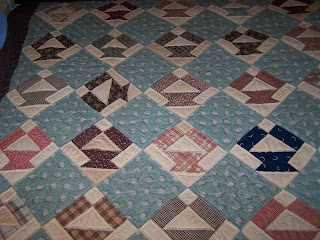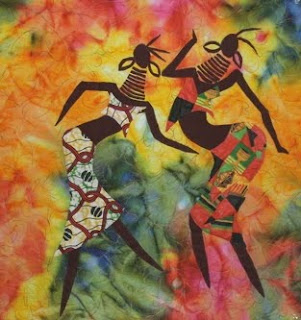I saw one of Wendy's newest pieces at the height of the oil spill anger and frustration and fell in love with her depiction of this horrific event. She reminded me that in nature, everything has beauty, even ugly oil spills at some molecular or magnified level has its own beauty. Now whether the one covering the beaches and Gulf of Mexico has such beauty, I don't know, but through Wendy Mamattah's eyes -- it certainly does. I'd love to hear of others who have been inspired by the Gulf disaster and see your work as well.
If you are unfamiliar with Wendy's work, you are in for a treat! And if you're familiar with her work, you know this will be an inspiring time as she tells us about her work and techniques.
Photo 1 and 2: Beautiful Nonsense and detail: Fabrics used were African print and black Swiss linen.Work is machine stitched, heavily trapunto’d, and machine quilted.Work is also hand painted and meticulously hand beaded. 34-1/2x53.
Now, here is Wendy Mamattah in her own words. -- Dawn
Wendy Mamattah
With a major in journalism and mass communication, the main medium connecting me with the world is news. I have it running all day as I quilt. I love to have the scoop of every thing as it happens right there in the moment. Which is why I happened to be tuned in when the horrific oil spill disaster in the Gulf made headlines. I thought of the lives that were lost, and the grieving families, and how fragile life was. As I slept that night, I dreamed this piece -- an abstract work on this tragedy. That is how 'Beautiful Nonsense' was born.
Every day starts with my creativity kicking in right away, and then I just dance with fabric! and I love that! Creativity is inherent in every individual, you just have to wake it up sometimes, there are lots of people who have let their creativity go to sleep, letting the fire in them die while they are still alive. Creativity in all aspects needs to be stimulated to grow, human beings were not created sedentary, but rather born to evolve.
I have always loved working with fabrics. Even as a child, born in Ghana in West Africa, as early as age five in primary school, I often received prizes for needlework instead of English or Geography, which made me realize that there was a part inside of me that loved to create. My creative side comes from my mother, a bridal dress designer who contributed a great deal to the fashion scene in Ghana in her day.
As a child I never took any special sewing class, apart from the needle work class in primary school,which was were very minimal, but I would observe my mother as she sat and worked at her sewing table, and with my little photographic eye, I would make a mental capture of what she sewed and try to recreate what she made, I made little bridal gowns for all my dolls, and the next step was making my own clothes.
By the time I turned age twelve I was my own dress maker, and I had then become more aware of my special little gift which I had began to appreciate so much. I realized that I was in total control of it, because I could dream of any thing I wanted to wear, and I had the power to create it!
Quilting came to mind when I left Africa to live in England in the early 90's, but it did not take me long to realize that it was more of an American folk art, and so when I moved to the United States in the later part of the 90's I started to consider how I could use my rich African heritage as a vessel of expression through art, and education.
With all these little childhood projects still fresh in my mind, together with my mothers bridal flair and the impact that had on me, my first Quilt "And She said Yes' was an African inspired bridal scene which I created to honer my mothers memory and her bridal work. This is a silhouette art work of a bride gazing into her grooms eyes on her wedding day at sunset. Most traditional African weddings take place at sunset.
And She Said Yes!
Artist Statement: Fabrics used are hand dyed fabrics, Kente prints.
Hand beading technique, machine appliqued and quilted. 28x34-1/2 inches
I have always thought of bringing African inspired quilts, both traditional and art quilts to the table, in a way that will reflect the true African culture and heritage which I so much behold, and which I have in me so strongly instilled, and also present them in a way that will take up the world on a whole new dimension.
I created 'Under the African Waters' after watching a lot of the world geographic channel, I started to imagine what the under water life of the West African coast line might look like with all those exotic fish and under water creatures, so I got to work creating this piece using both African and western fabrics. This art work is the winner of the ‘Sharon Guthrie 2010 Memorial Award for Innovative Arts’ at the ‘2010 Festival of Quilts Expo’ in Portland Oregon in March.
Artist Statement: Work is raw edge machine appliqued.
Heavily reinforced with silver thread painting to give it shine. Hand beaded. 32x17-1/2-inches
The excitement of that winning quilt led me on to create a sequel 'OH! What a Wonderful World' also an under water scene which just recently got juried into the upcoming Milwaukee Machine Quilters Show, coming up in August from the 3rd-7th.
'OH! What a Wonderful' World here)`
This work is hand beaded, painted, machine appliqued, machine stitched and quilted.
Fabrics used are hand dyed cotton and organza fabric. 44 1/2 x 31-inches.
My work continues to evolve in both subject and technique. Recurring throughout in strong, clear color, texture, visual impact, and meticulous detail. I love the colors of the world as it is. I love the colors that can be imposed on the real world to see it in a new way. The world is enlivened not only by color but also by its textures. I want to get in close and observe the nearly hidden textures of all of the creations of nature. I want to climb up high and see the equally hidden textures of the world as a bird might see it. I want to examine the faces and postures of the people who share the world with me.
'Walking home from the market' reflects the typical day to day life style in any African village, women going to the river side to fetch water, or to wash clothing, and others returning home from the market to cook the evening meal, since women are more of home makers in Africa by tradition. The clothing the three ladies wear in this art work is pieced using the traditional method of piecing.
Walking Home From the Market
Art work is raw edge machine appliqued and machine quilted.
Hand dyed fabric for the background and a medley of Kente Prints. 28-1/2x35 inches
The expression of traditional drumming and dancing is how Africans connect during festivities, families come together, broken relationships and friendships are mended, and marriages also take place, these two quilts Kpanlogo and Asabone represent how people celebrate in Ghana and all over Africa.
Kpanlogo
This art work is raw edge machine appliqued and also machine quilted with Kente prints. 26x28-inches
Asabone (Wild Dancing)
Work was machine appliqued and machine quilted and Kente Prints. 26x28-inches
All my current works depict Africa. I love the vibrant colors of African fabrics and how they pop to the eye, most of my quilts tell a story, and a lot of my story’s represent my African heritage which I carry with me every where I go, I feel when a quilt does not tell a story no matter how simple it might be it really does not have value, since quilts of old were sentimental pieces.
The crocodile lives in the water, yet breathes the air, demonstrating an ability to adapt to circumstances. 'Denkyem' the akan name for crocodile is a symbol of adaptability and perseverance, I have fallen many times in my life, and have always found the strength and courage to get up, the strength of this symbol is very dear to my heart. I dreamed this piece in an art work and I came up with this.
Denkyem (Crocodile)
Work is raw edge appliqued and machine quilted.
Hand dyed fabric and Kente Print. 29x35-inches
My final piece which I want to introduce is 'Faith Hope and Love' which are three tribal mask faces, in Africa tribal masks relating to all the different tribes are commonly seen around every corner. I dreamed this piece in blue.
Faith Hope and Love
Work was raw edge appliqued and satin stitch quilted.
Back ground fabric as batik. 27x33-1/2-inches.
My quilts, people have said, sing and dance to the viewer, and have lots of character and dimension as well as a very unique look which are the differences my choices of fabric make. Beading and painting really accentuate my work.
People often ask me when ever I do a show and tell at my local quilting guilds "whats next on your design wall?" and I often answer 'its a surprise" I have two more works coming up in the next few weeks one abstract about the Fulani nomadic tribe in Africa, and a marble mosaic art work, using a technique I created myself to represent the 'Dipo' festive puberty rite for young girls. That's what Wendy has on her design wall, and I am keeping it coming!!
Since beginning this blog, I've completed yet another in the series of African art quilts.
The Masai are semi-nomadic people located in Kenya and northern Tanzania. Due to their distinctive customs and dress, the Massai choose to reside near the game parks of East Africa, they are among the most well known of the African ethnic groups. They speak Maa, a local dialect., as well as Swahili and English. They are live stock farmers, and I have always been intrigued by their unique appearance, the stretching and piercing of the their ear lobes, including the thorns they use for piercing, as well as twigs, stones, the pieces of elephant tusks, and empty film canisters they wear in their earlobes. Red is the most favored color of the Massai men. I created this abstract work to communicate to the viewer the beautiful story of the Masai people of East Africa. Size 55x26-1/2-inches.





























.jpg)
















